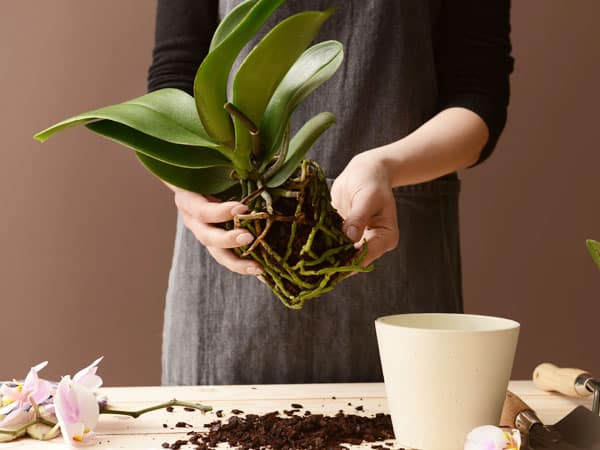Orchids are ornamental plants that many people love because of their gorgeous beauty and variety of colors. Orchids always attract people’s eyes with their brilliant flower clusters in the sun.
However, orchids also require careful care and perseverance to get bright and long-lasting flower clusters. One of the issues that many people wonder about during the care process is watering orchids when changing pots.
Should I water the orchid after repotting? Does watering immediately after repotting affect the adaptation of the root system? When is the best time to water? To answer these questions, let’s learn the details of watering orchids in this article.
Should I Water The Orchid After Repotting?
As you know, water is an indispensable element for the growth and development of plants. Water plays an important role in healing plant diseases such as wilting, drought, lack of water, or wilting leaves. However, watering orchids immediately after repotting also needs to follow basic principles to ensure survival.

Only Water When The Roots Are Intact
The root system of an orchid is a complex scheme. Their roots can entwine or cling to the bark like a spider’s web. Therefore, when repotting, it is extremely difficult to preserve the intact root state.
In particular, orchids also do not like to be rooted or changed into pots in a new environment. This plant often reacts like wilting or drooping leaves to sudden stress.
The roots of orchids are made with a protective coating called velamen. Most are layers of dead cells responsible for retaining water and moisture inside the hollow tube and close to the main fiber of the root. The small roots attached to the trunk and pot will provide better surface contact in absorbing nutrients and retaining moisture.
So when you repot, try to keep the orchid’s roots intact so as not to disturb the mechanism. You only need to remove the extra roots if they are damaged or broken during the change.
After that, you can water normally to help the orchid acclimate to its new habitat. When the roots are intact, they will still do their normal job to absorb water and nutrients to nourish the orchid.
However, you should control the amount of watering to avoid waterlogging due to over-watering. This will easily bring negative effects on the orchid. When the root system has not yet adapted to the new soil environment, waterlogging will create favorable conditions for bacteria to attack and disrupt the operating mechanism of the orchid.
The roots will be completely defenseless when not adapted to the new environment. Therefore, you should water slowly with a small amount and gradually increase when the orchid has shown signs of adapting to the new environment.
Do Not Water Immediately When The Root System Is Damaged Many Branches
On the other hand, if the orchid’s roots are severely damaged, you should not water it immediately. In some cases, you will need to repot a new pot such to root rot, overcrowding, or root attack by pests.
You will need to remove weak, damaged, or rotten branches and keep only healthy roots for replanting. So watering is not recommended in this case. Like a wound on our skin, it takes time to heal in a dry environment.
You should not water orchids immediately after repotting because water will make open wounds in the root system susceptible to bacteria attack. They need time to dry out to heal and can adapt to a new environment.
In particular, there are many species of bacteria that live in water and are transmitted through drops, mists, sprays, or even daily watering. If you water it right after repotting, you are inadvertently giving bacteria access to an open wound in the orchid’s roots.
So, after you cut off the damaged roots of the orchid, you need to clean the cut as well as use medicine to create a barrier against bacterial attack. You can use a bactericide or fungicide like Physan 20 to prevent bacteria from attacking.
When Should I Water My Orchid After Repotting?
Before repotting, you should soak the orchid in water for about 20 minutes. This will help the orchid to absorb enough water for the stem and leaves. It will also make it easier for you to separate the root system from the pot. Water will reduce stress and high friction to avoid damage to the root system.
After you have successfully repotted, you should not water immediately and wait 1 week later. Usually, when you repot an orchid, the root system will be broken and damaged. Therefore, to be on the safe side, you should wait 1 week when the open wounds have dried and can recover to continue the water transport process.
You should only water a small amount of water and gradually increase over time when the root system has fully recovered and adapted to the habitat. If the roots of your orchid are damaged too much, you should keep a dry environment so the cut can heal faster.
In particular, once again emphasizing, you should treat the cuts with a disinfectant solution to prevent bacteria and fungi from entering the root system.
Conclusion
Watering the orchid after repotting will depend on the damage to the root system. If the orchid’s roots are intact and almost undamaged, you can water it as soon as you repot it.
However, if the roots are damaged, broken, or broken due to waterlogging, or pests, you should not water them after repotting. Water will make it difficult for wounds and cuts to heal. Besides, water also contains many bacteria, so it will easily enter the roots through an open wound and attack your orchid.
You need to do this watering process slowly and watch for signs of orchids in the new environment. Do not over-water as the roots can become waterlogged and bacteria will enter the roots from open wounds.